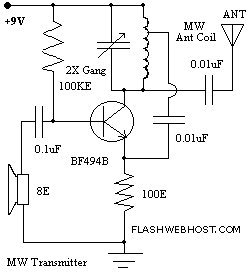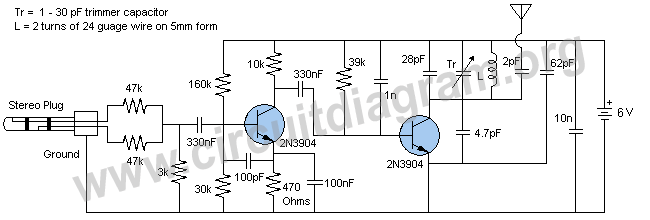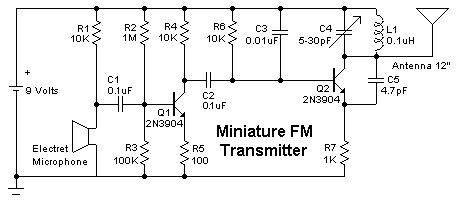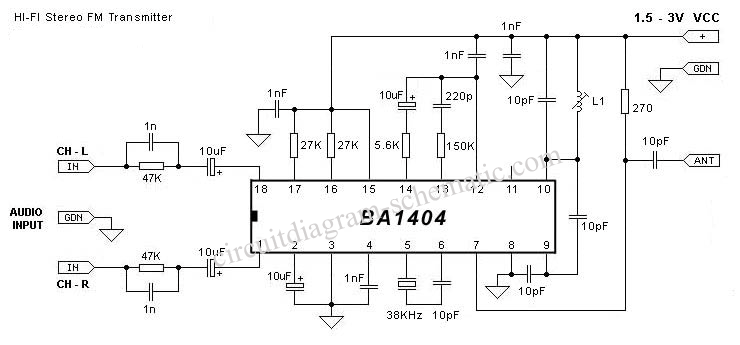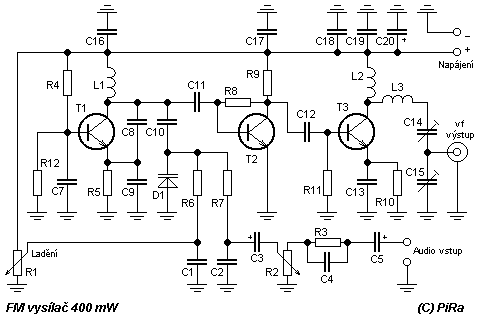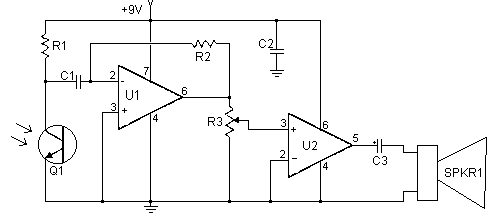
3W FM Transmitter
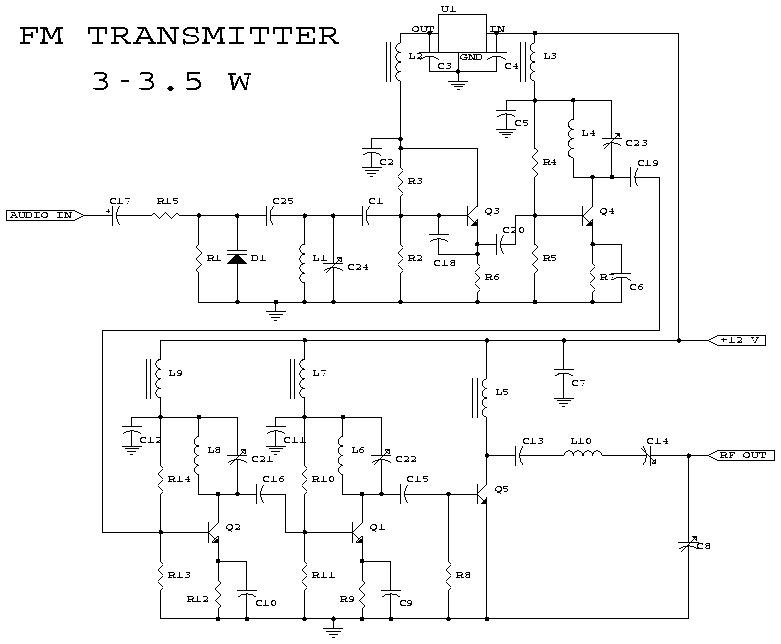
This schematic represents an FM transmitter capable of delivering an output power of 3 to 3.5 watts, operational within a frequency range of 90 to 110 MHz. While the inherent stability of the circuit is acceptable, the implementation of a Phase-Locked Loop (PLL) can enhance performance. This circuit was constructed several years ago for a friend, who utilized it in conjunction with a BLY88 amplifier to achieve a total output power of 20 watts. According to the original schematic notes, the transmitter functioned effectively with a Standing Wave Ratio (SWR) of 1:1.05, which is typical for the antenna setup used in that location. The circuit has been validated on a standard RF-testing breadboard featuring copper on one side, and connections were made between both sides. It is recommended to house the transmitter in an RF-shielded enclosure, utilize high-quality connectors and cables, and ensure proper shielding between various stages of the circuit, adhering to established RF construction guidelines.
This FM transmitter circuit is designed to operate efficiently within the specified frequency range, making it suitable for various applications such as amateur radio broadcasting or personal use. The output power of 3 to 3.5 watts is adequate for local transmission, while the potential for increased power via the BLY88 amplifier allows for expanded reach and versatility.
The circuit's architecture typically includes essential components such as oscillators, modulators, and amplifiers, which work together to generate and transmit the modulated signal. The inclusion of a PLL can significantly improve frequency stability, reducing drift and ensuring consistent performance over time. This can be particularly beneficial in environments where signal integrity is paramount.
Attention to detail during construction is crucial. The use of an RF-proof casing minimizes interference and signal degradation, while high-quality connectors and cables maintain the integrity of the signal path. Proper shielding between stages helps prevent unwanted interactions and noise, which can adversely affect performance. Following RF design principles, such as maintaining appropriate impedance levels and ensuring good grounding practices, is essential for achieving optimal results.
Testing the circuit on an RF breadboard allows for initial validation of functionality, but further testing in a controlled environment is recommended to ensure compliance with local regulations and performance expectations. Overall, this FM transmitter design offers a solid foundation for anyone looking to explore or expand their capabilities in RF transmission.This is the schematic for an FM transmitter with 3 to 3. 5 W output power that can be used between 90 and 110 MHz. Although the stability isn`t so bad, a PLL can be used on this circuit. This is a circuit that I`ve build a few years ago for a friend, who used it in combination with the BLY88 amplifier to obtain 20 W output power. From the notes tha t I made at the original schematic, it worked fine with a SWR of 1 : 1. 05 (quite normal at my place with my antenna). 2. The circuit has been tested on a normal RF-testing breadboard (with one side copper). Make some connections between the two sides. Build the transmitter in a RF-proof casing, use good connectors and cable, make a shielding between the different stages, and be aware of all the other RF rules of building. 🔗 External reference
This FM transmitter circuit is designed to operate efficiently within the specified frequency range, making it suitable for various applications such as amateur radio broadcasting or personal use. The output power of 3 to 3.5 watts is adequate for local transmission, while the potential for increased power via the BLY88 amplifier allows for expanded reach and versatility.
The circuit's architecture typically includes essential components such as oscillators, modulators, and amplifiers, which work together to generate and transmit the modulated signal. The inclusion of a PLL can significantly improve frequency stability, reducing drift and ensuring consistent performance over time. This can be particularly beneficial in environments where signal integrity is paramount.
Attention to detail during construction is crucial. The use of an RF-proof casing minimizes interference and signal degradation, while high-quality connectors and cables maintain the integrity of the signal path. Proper shielding between stages helps prevent unwanted interactions and noise, which can adversely affect performance. Following RF design principles, such as maintaining appropriate impedance levels and ensuring good grounding practices, is essential for achieving optimal results.
Testing the circuit on an RF breadboard allows for initial validation of functionality, but further testing in a controlled environment is recommended to ensure compliance with local regulations and performance expectations. Overall, this FM transmitter design offers a solid foundation for anyone looking to explore or expand their capabilities in RF transmission.This is the schematic for an FM transmitter with 3 to 3. 5 W output power that can be used between 90 and 110 MHz. Although the stability isn`t so bad, a PLL can be used on this circuit. This is a circuit that I`ve build a few years ago for a friend, who used it in combination with the BLY88 amplifier to obtain 20 W output power. From the notes tha t I made at the original schematic, it worked fine with a SWR of 1 : 1. 05 (quite normal at my place with my antenna). 2. The circuit has been tested on a normal RF-testing breadboard (with one side copper). Make some connections between the two sides. Build the transmitter in a RF-proof casing, use good connectors and cable, make a shielding between the different stages, and be aware of all the other RF rules of building. 🔗 External reference
